“He has attacked aerodromes near Berlin, has run amok among German flying schools in supposedly safe areas, and has “floored” transport aircraft probably carrying high military personages.“
Morning Bulletin (Rockhampton, Qld) May 22nd, 1944, Page 3.
CHARLES “CHARLIE” CURNOW SCHERF DSO, DFC & BAR
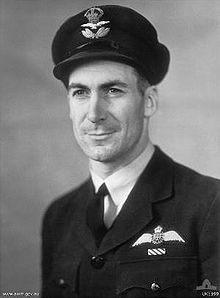
Charlie was one of Australia’s top 10 air aces in World War Two, with 14.5 aircraft shot down, plus 9 destroyed on the ground and 5 damaged (with this tally he was ranked the 9th Australian overall for aerial victories). This was achieved in 1943-1944 during 38 missions over Europe in which he covered an amazing 80,467 operational kilometres (50,000 miles) and never received even a scratch!
FAMILY CONNECTION
Charles Scherf (May 17th, 1917 – July 13th, 1949) was also the first cousin of my Great Grandfather and someone who my Grandfather would tell me about when I was younger. Although my Grandfather never got a chance to meet him, he was a hero to him and later a hero to me (while Charlie was belting about over Europe in 1944 my Grandfather was around 17 years old and in the Royal Australian Air Force Air Training Corps, passing his Proficiency Certificate with Distinction and probably hoping to follow in his footsteps – the war ended before he ever got a chance to progress any further though). Both men were a major influence in my own interest in aviation and this is my ANZAC day tribute to Charlie.
BACKGROUND
Charlie grew up on a farm (“Big Ben”) at Emmaville near Glenn Innes, New South Wales in Australia and prior to World War Two he enlisted in the Citizens Military Force (a predecessor of the Australian Army Reserve) in 1934 and served for 3 years in the 12th Light Horse Regiment where he reached the rank of Corporal, then got married on August 23rd, 1939 to Florence Hope O’Hara (later to have 4 children – 3 daughters and 1 son) and worked on the family farm. He was by all accounts a very likeable and good-natured man.
On September 12th, 1941 he joined the Royal Australian Air Force (service number: 413671). Once his training was completed (with an above average rating) in July 1942 he was commissioned as a Pilot Officer and left for Britain by ship in September 1942. Where upon arrival he underwent advanced training and was promoted to Flying Officer.
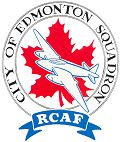 418 “THE CITY OF EDMONTON“ SQUADRON & THE “WOODEN WONDER“
418 “THE CITY OF EDMONTON“ SQUADRON & THE “WOODEN WONDER“
Although an Australian, in August 1943 Charlie joined Royal Canadian Air Force 418 Squadron which was based in Britain, and commenced flying operations over France, Germany and the Baltic Sea against German forces. He had become friends with a Canadian observer during training and ended up the only Australian in the all Canadian squadron. In December 1943 he was promoted to Flight Lieutenant and by March 1944 he was an acting Squadron Leader.
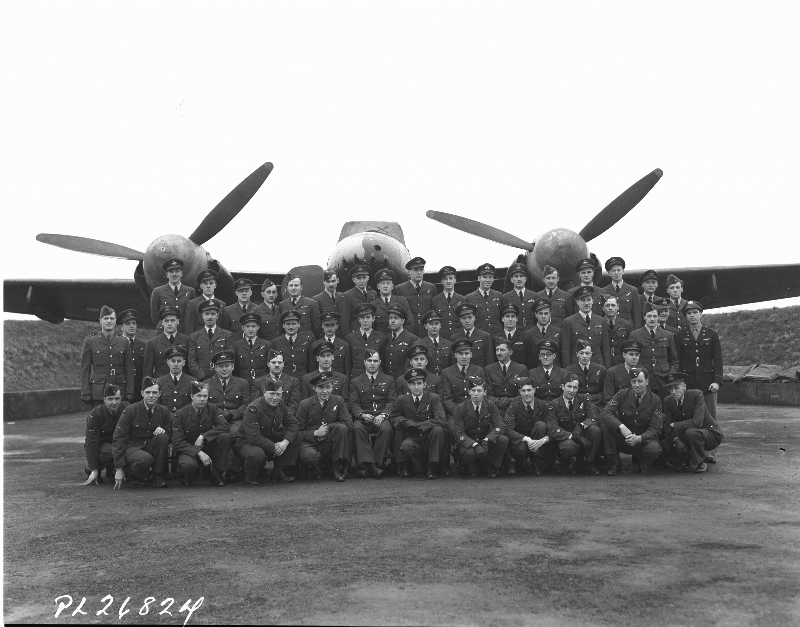
The aircraft Charlie flew in 418 Squadron was the 2 seat de Havilland Mosquito FB.VI fighter bomber (from what I can ascertain he mainly flew “Cousin Jake” TH-F HJ715 but had also flown “City of Edmonton” TH-J HX819). The “Mossie” was made almost entirely of wood (“The Wooden Wonder” – basically intended to overcome a shortage of metal), powered by 2 Rolls Royce Merlin engines it was very fast (top speed 380 mph / 612 km/h), had a long range and was heavily armed (4 x 20mm Hispano cannons and 4 x .303 Browning machine guns mounted in the nose, a bomb bay for 2 x 250-lb /113 kg, plus either bombs or rockets under the wings). A very formidable aircraft and one of the best built in World War Two.

The primary mission of 418 squadron was day/night intruder missions over Europe (interestingly given the night operations, the aircraft were not fitted with radar to detect targets, for the first few months they did not get many aerial victories, a switch to daylight operations soon changed this though). These intruder missions would have been low to the ground (to avoid radar and early detection) and at high speed. The main purpose of the mission was to target airbases behind enemy lines, shooting up anything that go in their way be it enemy aircraft in the air, on the ground or in some cases floating on water. They would also have targeted enemy shipping, trains and the like. It must have been one hell of a rush and at times terrifying I am sure!

According to Squadron Leader A.P. Heathcote of the Air Historical Branch in the “History of No. 418 Squadron” it was the top fighter squadron in the RCAF in both air to air and air to ground kills. They were referred to as the “finest in the World“. The 418 Squadron motto in Inuit: Piyautailili (‘Defend Even Unto Death’).

In 37 months 418 Squadron destroyed 178 enemy aircraft (73 on the ground), 9 probables, damaged a further 103 aircraft and destroyed 83 V-1 Flying Bombs. On the ground they destroyed 200 vehicles (damaged at least 400 more), 16 locomotive engines (23 more were probably destroyed and 36 more were damaged), 52 railway cars (cargo and passenger) were destroyed or damaged (another 50 trains at least were also hit with lesser damage). On the water 3 barges/trawlers were sunk and 20 others damaged. On top of this the squadron destroyed a bridge, damaged 10 factories and took out hundreds of searchlights, defensive positions and other targets.
All of this was achieved by 418 Squadron with the loss of only 59 aircraft (a ratio of 3:1 in their favour). Sadly 94 squadron aircrew were killed and 27 were recorded as “fate unknown” (an additional 14 were captured). 62 decorations were awarded to 418 squadron aircrews for valour.
MISSIONS AND THE “LAST TRIP”
Secret Missions
Charlie was involved in a number of “secret missions” including an interesting one where three aircrews from 418 Squadron were temporarily allocated to the famous Avro Lancaster 617 Squadron – “The Dambusters” to act as an escort on a raid on the Dortmund Ems Canal (a major German industrial waterway) on September 15th, 1943. The plan was for 8 Lancaster’s to fly at low altitude and each drop a massive 12,000 pound high-capacity “Tallboy” bomb to breach the canal walls and have the water drain out to cripple the movement of shipping and cargo along the waterway (including valuable iron ore from Sweden). The Mosquitos were there to protect the bombers from fighter aircraft and to take out searchlights and anti-aircraft guns.
Unfortunately the canal was shrouded in fog, the bombers took some time to find their target which was highly defended by anti-aircraft guns (much more than on the famous “Dambusters” raids in May 1943), while they were flying above they became easy targets and 5 of the 8 bombers were shot down. The mission was a total disaster and heavy bombers were not used in this low level way again (the canal was eventually breached in 1944 by Lancaster’s again using the “Tallboy” bombs).
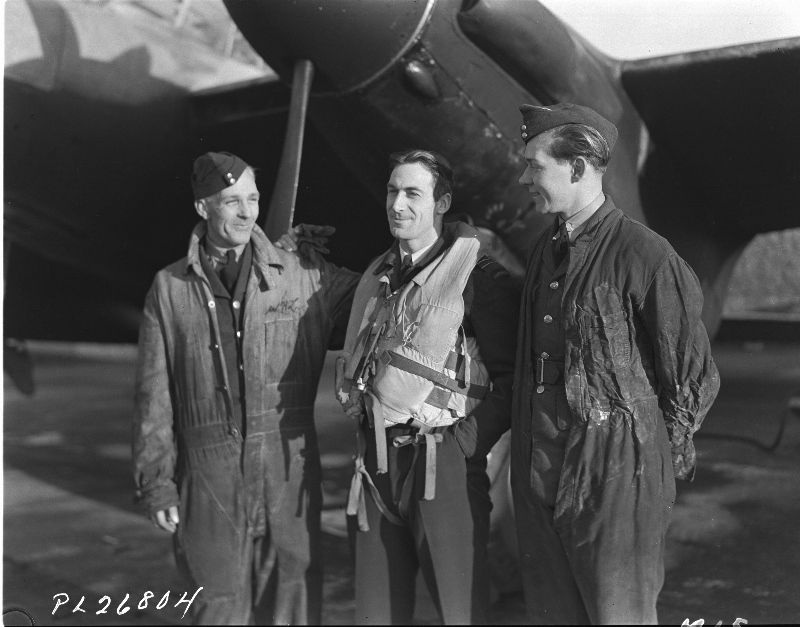
The “Monstrosity”
In February 1944 Charlie came upon something over Dole, France that he dubbed “one of the funniest sights I’ve ever seen“. He and his wingman were confronted with an unusual “monstrosity” of an aircraft, the Heinkel He 111Z Zwilling of the German Luftwaffe which was two Heinkel He 111 bombers joined together at the wing, with an additional engine added to be a glider tug. The He 111Z was towing two Gotha Go 242 transport gliders. His wingman noted that the He 111Z had a large number of gun positions. He and his wingman shot down all the aircraft. This contributed to his tally as a one and a half aerial victory.
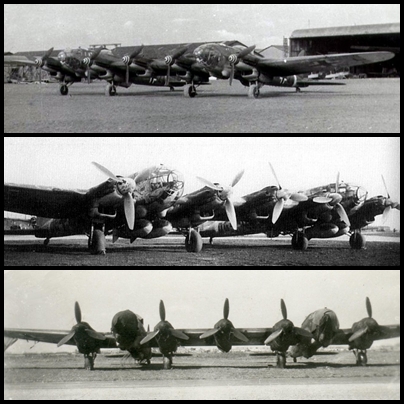
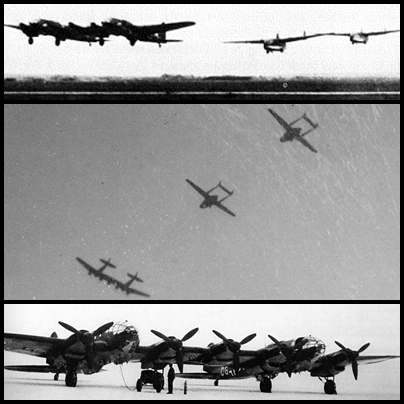
The following photo is actual gun camera footage from his aircraft of the destruction of the He 111Z in February 1944. This mission marked the “official” end of his operational tour of 30 missions (with 5.5 aerial victories) and he was transferred to Air Defence Headquarters to be controller of intruder operations in March 1944, but he had a restless spirit and when “off duty” he would still fly missions with 418 Squadron.
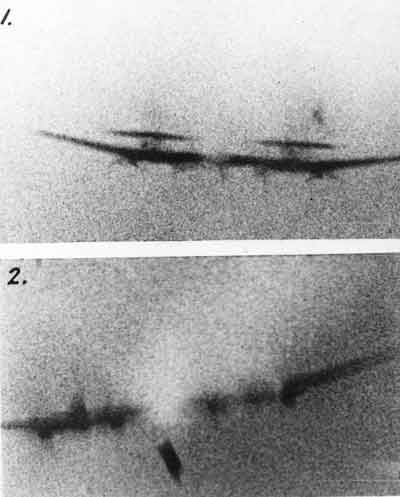
“Last Trip” Scherf
Interestingly most of Charlie’s aerial victories were scored when he was on “holidays” from his new desk job (8 aerial victories)! This earned him the new nickname “Last Trip“.
On one such “holiday” mission over the Baltic coast on May 16th, 1944 he shot down 5 Luftwaffe aircraft (this incident was widely reported in newspapers in Australia, Canada and the United States). On that day he downed 1 Heinkel He 111 bomber, 1 Heinkel He 177 Grief bomber which he attacked head on resulting in it exploding in the air, 1 Junkers Ju 88 bomber, 1 Junkers Ju 87 Stuka dive bomber and 1 Focke-Wulf Fw 190 fighter which apparently first fired a rocket at him, luckily missing (the Fw 190 was one of Germany’s most formidable fighters, heavily armed it was known as the “Butcher Bird” by Allied aircrews)! 4 of these aircraft were shot down in just 5 minutes! Plus he destroyed 2 other aircraft on the ground/water – a Heinkel HE 111 bomber and a Dornier Do 18 flying boat. All 7 of these aircraft were encountered in just 15 minutes in what was the most furious combat action of his flying career!
During this mission his aircraft suffered a minor hit from a 20mm anti-aircraft gun and then on the way back he hit a flock of birds that did some damage to his Mosquito putting numerous holes in the wing, but otherwise he and his navigator were unhurt! This was his last combat mission…what a way to finish his combat career!
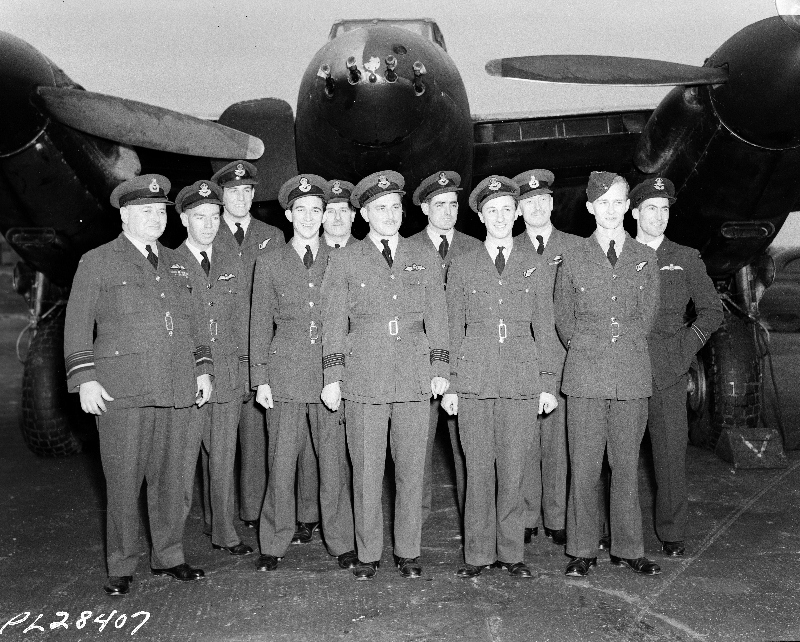
An Exceptional Pilot
Charlie was the first to organise long-range Mosquito raids in daylight and was recognized as one of the most decorated pilots. When he left 418 Squadron the Commanding Officer wrote in Charlie’s log book: “An exceptional pilot with outstanding fighting qualities, A. Barker W/Cdr, 418 Sqdn R.C.A.F.” He also destroyed more German aircraft in a single mission than any other intruder pilot. Quite a tour of duty!
AERIAL VICTORIES
The following German Luftwaffe aircraft were destroyed by Charlie in air to air combat between January 1944 and May 1944 for a tally of 14.5 (as recorded in Aces High 2nd Edition by Shores and Williams via Aces of WW2):
January 27th, 1944: 1 Focke-Wulf Fw 200 Condor reconnaissance/patrol bomber – Charlies first air to air victory.
February 18/19th, 1944: 1 Unknown night fighter – Charlie didn’t even have to fire a shot, he harassed this enemy pilot so much that he lost control and crashed into the ground in Belgium!
February 24/25th, 1944: 2 Junkers Ju 88 bombers.
February 26th, 1944: 1 Gotha Go 242 glider and 0.5 Heinkel He 111Z Zwilling glider tug – his share in shooting down the “Monstrosity” as mentioned earlier.
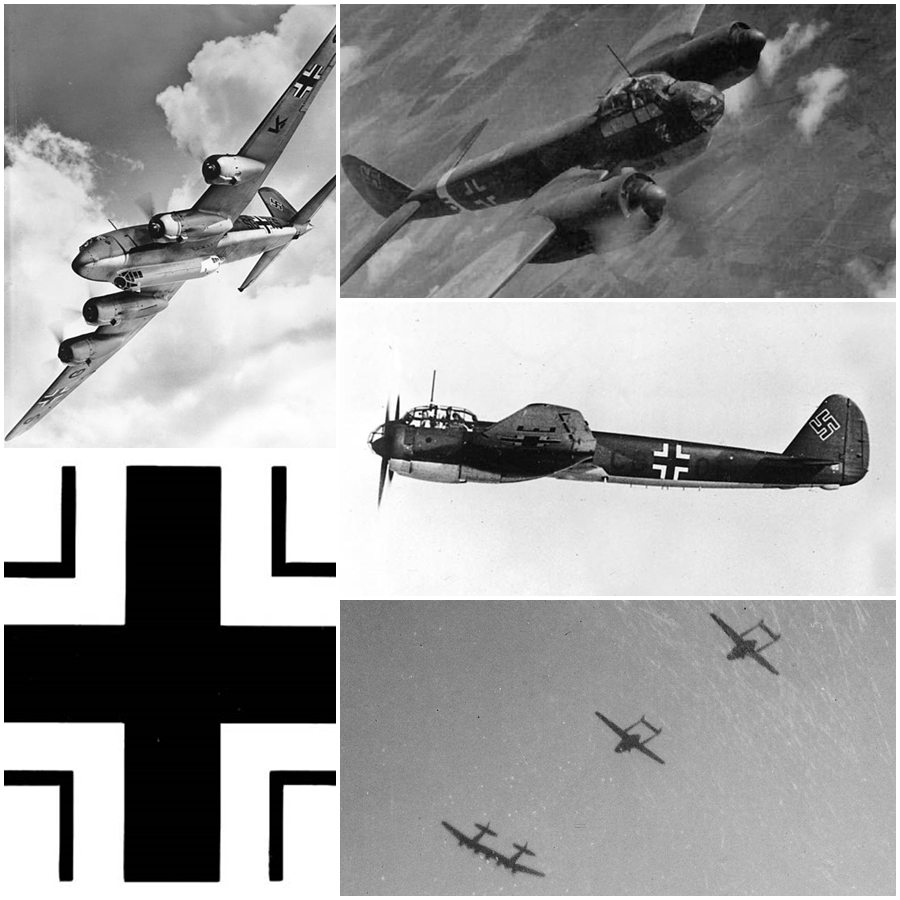
April 5th, 1944: 1 Messerschmitt Bf 110 twin-engined heavy fighter (or possibly a similar looking captured French Potez 630 heavy fighter), 1 Focke-Wulf Fw 58 liaison aircraft and 1 Fieseler Fi 156 Storch liaison/observation aircraft which was forced down and then destroyed on the ground (the official record lists this as an air victory).
May 2nd, 1944: 1 Junkers Ju 86P bomber.
May 16th, 1944: 1 Heinkel He 111 bomber, 1 Focke-Wulf Fw 190 fighter, 1 Heinkel He 177 Grief bomber, 1 Henschel Hs 123 dive bomber/close support aircraft and 1 Junkers Ju 86P (some old newspaper articles reported the last two as Ju-87 Stuka dive bombers) – 5 aerial victories in a day!
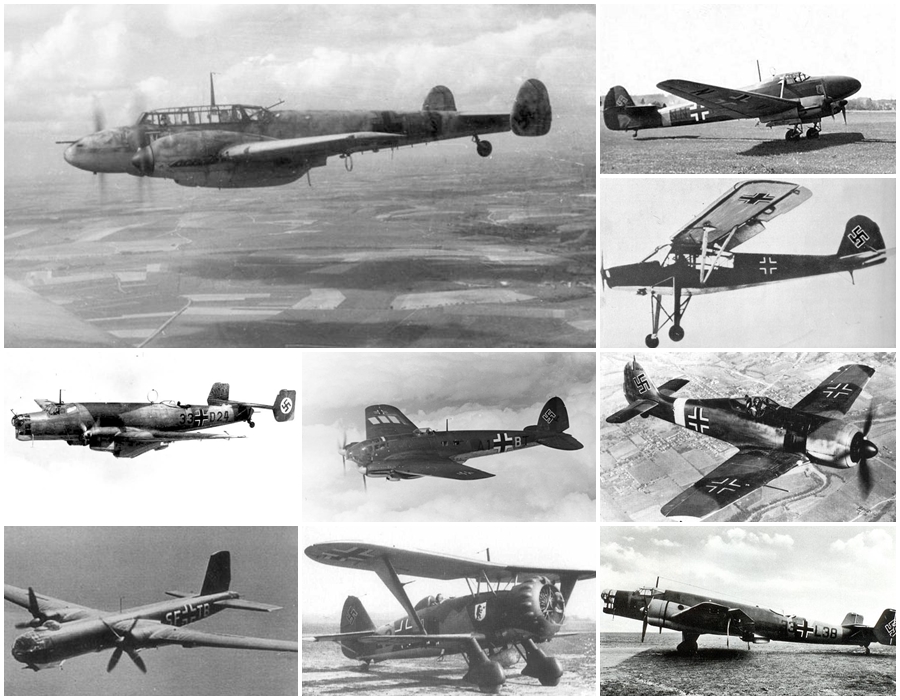
AIRCRAFT DAMAGED OR DESTROYED ON THE SURFACE
The following Luftwaffe aircraft were damaged (5) or destroyed (9) by Charlie between November 1943 and May 1944 on the ground or on the water in the case of the flying boats and float planes:
November 28th, 1943: 1 Bloehm & Voss Bv 222 flying boat (damaged).
February 21st, 1944: 1 Heinkel He 111 bomber (damaged).
February 26th, 1944: 2 Junkers Ju 52 transports (destroyed).
April 5th, 1944: 2 Heinkel He 111 bombers (destroyed).
May 2nd, 1944: 3 Heinkel He 111 bombers (destroyed), 1 Dornier Do 217 bomber (destroyed) and 2 Heinkel He 115 float planes (damaged).
May 16th, 1944: 1 Heinkel He 111 bomber (destroyed) and 1 Dornier Do 18 flying boat (damaged)
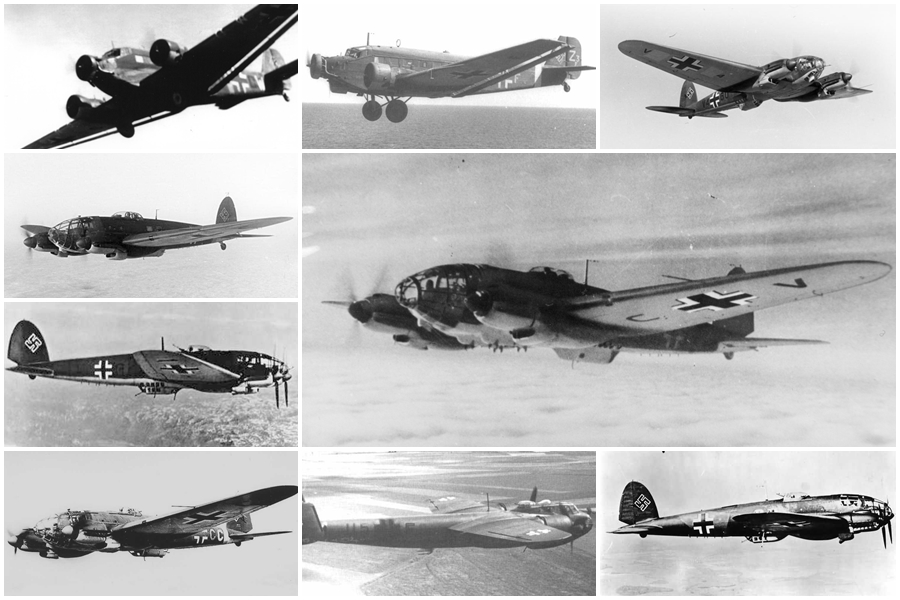

MILITARY AWARDS
His flight based heroics between 1943 and 1944 resulted in Charlie being awarded some of the highest medals possible within Commonwealth nations:
 Distinguished Flying Cross (DFC) awarded for “an act or acts of valour, courage or devotion to duty whilst flying in active operations against the enemy” during his night-time operations between late 1943 and early 1944 (including the Dortmund Ems Canal raid and the destruction of 4 aircraft at night). This award was mentioned in the London Gazette on April 4th 1944 for his night-time flight exploits.
Distinguished Flying Cross (DFC) awarded for “an act or acts of valour, courage or devotion to duty whilst flying in active operations against the enemy” during his night-time operations between late 1943 and early 1944 (including the Dortmund Ems Canal raid and the destruction of 4 aircraft at night). This award was mentioned in the London Gazette on April 4th 1944 for his night-time flight exploits.
“his example of courage and determination has been worthy of great praise“.
A DFC Bar was added one month later (basically a second award) for shooting down multiple aircraft and destroying/damaging other aircraft on the ground during 2 missions in February and March 1944 (this included the destruction of the He 111Z and 2 other aircraft destroyed and 3 damaged in April 1944). This award was mentioned in the London Gazette on May 12th 1944.
“has continued to display the highest qualities of gallantry and skill“.
Distinguished Service Order (DSO) awarded for “meritorious or distinguished service” where he destroyed 6 aircraft in the air and damaged 3 on the ground over 2 missions in May 1944 (this included his bag of 5 in one mission). This award was mentioned in the London Gazette on June 27th, 1944.
“His successes are a splendid tribute to his great skill, enterprise and fearlessness. This officer has set an example of the highest order“.
By wars end Charlie had been presented with 7 medals. They are pictured in order below: Distinguished Service Order; Distinguished Flying Cross and Bar; 1939-45 Star; Air Crew Europe Star; Defence Medal 1939-45; War Medal 1939-45; Australia Service Medal 1939-45. All of the medals, his logbook, a piece of airframe from his damaged Mosquito, photographs, letters and other documents including a scrapbook were sold in 2008 by Noble Numismatics in Sydney, Australia for $45,000 (how I would have loved to have seen all of these items)!
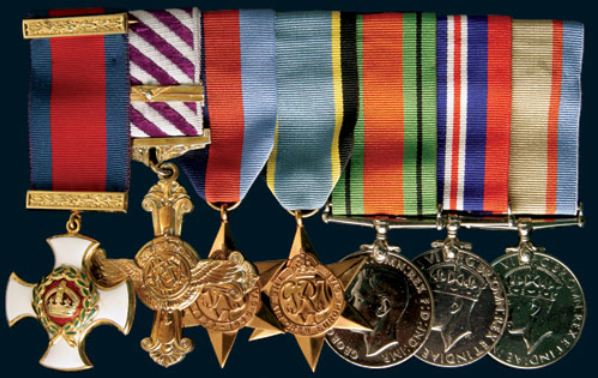
IN THE AUSTRALIAN NEWS
Even though interdictor pilots were probably not put in the spotlight as much as traditional fighter pilots who engaged in dogfights with other fighter aircraft (such as Australia’s highest Ace in World War Two Clive “Killer” Caldwell), Charlie’s exploits and awards were also widely reported back at home, featuring in many newspapers around Australia in 1944 (in addition to newspaper reports in the Britain, Canada and the United States). My favourite was a comic strip “He Hunted Huns In A Wooden Wonder” printed in The Argus (Melbourne, Victoria) on July 8th, 1944. The following images were sourced from the My Heritage – Scherf Website.
Charlie’s 5 aerial victories in one day in May 1944 was also a popular story appearing in numerous newspapers in 1944. The following images are from the Morning Bulletin (Rockhampton, QLD) Monday 22nd May 1944 Pg.3, The Mercury (Hobart, TAS) Monday June 5th 1944 Pg.3 and the Army News (Darwin, NT) Thursday 21st September 1944 Pg.3.
The Australian Womans Weekly ran an article on April 21st, 1945 that had a nice and fitting touch “Britain will never forget them…” which featured Charlie along with other Australian pilots who served in Europe.
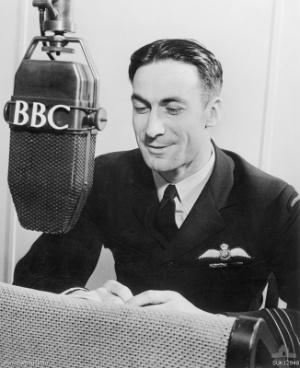
THE RETURN HOME
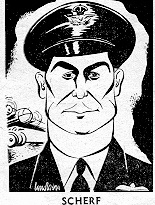 Charlie’s last flight in Britain was in a Supermarine Spitfire on July 8th, 1944 (he recorded in his log book “Last flight in a great country“). Returning to Australia in late 1944 he continued to serve with the Royal Australian Air Force in a number of roles including Chief Flying Instructor on the Mosquito at Number 5 Operational Training Unit based at RAAF Williamtown (NSW). I gather this didn’t impress him too much as he recorded in his log book on October 15th, 1944 “At 5 O.T.U. Australia “Worst Luck”.”
Charlie’s last flight in Britain was in a Supermarine Spitfire on July 8th, 1944 (he recorded in his log book “Last flight in a great country“). Returning to Australia in late 1944 he continued to serve with the Royal Australian Air Force in a number of roles including Chief Flying Instructor on the Mosquito at Number 5 Operational Training Unit based at RAAF Williamtown (NSW). I gather this didn’t impress him too much as he recorded in his log book on October 15th, 1944 “At 5 O.T.U. Australia “Worst Luck”.”
He also conducted test flying at RAAF Richmond and on April 11th, 1945 at his own request (to pursue a civilian career) he transferred to the Royal Australian Air Force Reserve. I have heard a number of times from family and people who were there at the time, of Charlie flying over his hometown of Emmaville and nearby Glenn Innes in 1945 at tree top height (and possibly lower if the flying under a bridge story is true) to show the locals how he did things back in Europe! This must have amused him highly as it gave the townspeople quite a shock! This may have been somewhat responsible for the entry in his service record, dated October 19th, 1944: “To be seriously reprimanded (by general court martial)“. This was not the way to treat a hero! Sensibly given his service record and wealth of senior contacts who knew better, nothing ever came of this.
On February 16th, 1946, Charlie was physically presented at Government House in Sydney with his DFC, DFC bar and DSO which he was awarded in 1944. The awards were presented by the Governor-General of Australia, Prince Henry, Duke of Gloucester (a military man he served in this post from 1945 to 1947). On July 1st, 1947 Charlie was discharged from the Reserve unit and ended his Air Force career.
Rest In Peace
Charles Scherf DSO, DFC served his country with gallantry and came through the war physically unscathed (with some close calls I am sure), but reportedly suffered from Post Traumatic Stress over the people he knew who had died in the fight, and those Germans that he had killed (he said “the Germans he had killed seemed to march across his bed in the darkness“). This lead to him drinking heavily and driving his car at high-speed (the “slower pace” of civilian life must not have been easy for him to adjust to).
Sadly Charlie died on July 13th, 1949 at the young age of 32 from injuries sustained in a serious high-speed car accident near Emmaville. It is amazing that he could be involved in so many dangerous missions over Europe and never be injured, yet on the ground he was as fallible as we all are.
He was buried in the local Emmaville cemetery. His funeral was marked by the patrol of 2 RAAF CAC Mustang fighters circling overhead for 15 minutes and as the mourners gathered at the grave, the pilots flew over them with wings dipped. Just as the funeral ceremony was ending an RAAF de Havilland DH.98 Mosquito circled overhead and as the casket was being lowered the pilot dipped the wing in salute as it flew over the grave. A fitting tribute to a national hero from the plane that he flew so courageously.
R.I.P. Charles Curnow Scherf (RAAF photo)
A Mosquito Returns to the Skies
After a seven year reconstruction and restoration by Avspecs Ltd. in Auckland, New Zealand a de Havilland Mosquito FB Mk.26 fighter-bomber (KA114), “The Wooden Wonder” took to the skies once again in 2012 appearing at a number of flying events around Auckland (the first flight was September 27th, 2012). I was lucky enough to see her fly in New Zealand in January 2013 (the only one that was flight capable at the time). I am sure it would put a smile on Charlie’s face to know a “Mossie” is back in the skies where she belongs.
REFERENCES
Australian Dictionary Of Biography
National Air Force Museum of Canada, Bill Nurse – Researcher
National Archives of Australia
Sky Of Glory A French Website – which also sourced information from – ACES HIGH – Christopher Shores and Clive Williams. Grub Street Editions (1994)
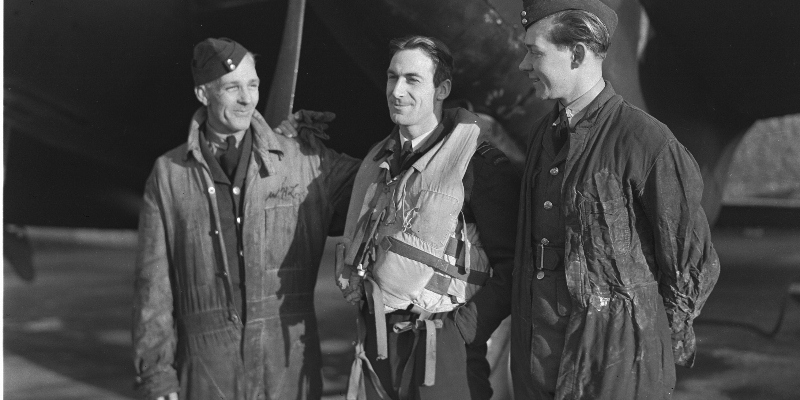
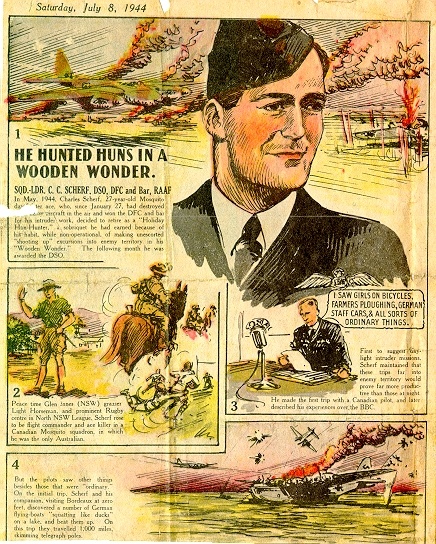

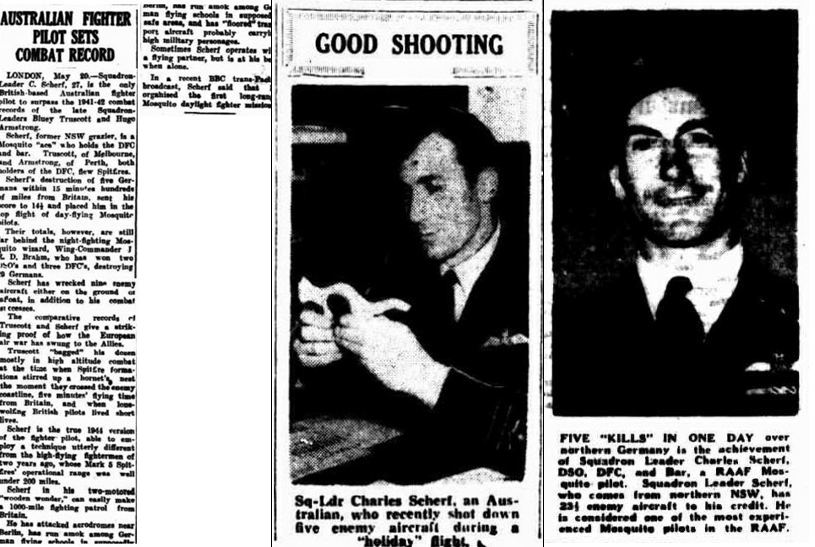
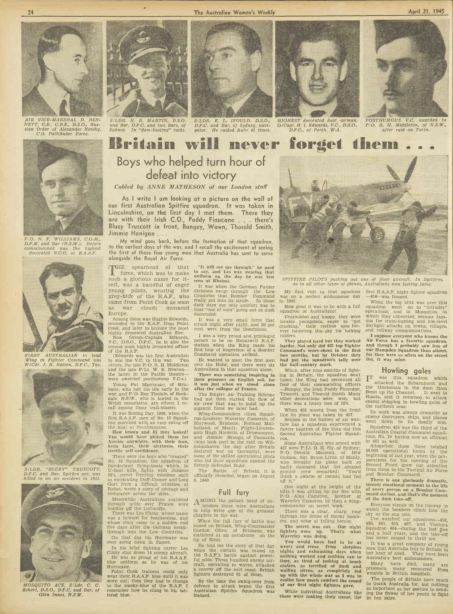




Dear Deano,
I am Rosemary Scherf, the daughter of your self-confessed hero, Charles Scherf. I was looking up some details about Dad and found your new web page which was a bright and entertaining compilation of his life. Thank you for your great efforts- it is so interetsing for me to see how my father’s fame continues to spread to the younger generations.Indeed he was an outstanding man but I also notice that you did not include any details about his children or our mother, Charles’ wife. HIs life and death affected us in ways that no one will ever understand. Anyhow, I am anxious to find out who you are, seeing you appear to be related to our family in some way.
Thanks a lot for your wonderful tribute, Deano, and looking forward to hearing from you.
Rosemary
LikeLike
Hi Rosemary,
Thankyou for taking a look at my blog and for your kind words. I am the eldest grandson of David James (sadly also now lost to us) and the nephew of Marjie James who you may have met at one of the Scherf family reunions (I personally have not been to one). I have always been interested in aviation, particularly Australian related pilots and achievements.
It was quite interesting doing more research into the life of Charles than I had previously read about when I was younger. The Canadian Air Force museum were very helpful in providing some additional photos that I used in the article too. My apologies for only briefly mentioning that Charles married and had 4 children – I decided to mainly keep things as closely linked to his military career as possible.
Thanks again
Dean
LikeLike
Hi Deano,
My name is Mark Edwards. My father, Neville, was born at Torrington, 26 kilometres from Emmaville. In March 1945 my father and Uncle Dave were on compassionate leave from the fighting in New Guinea – my grandmother was ill in Emmaville Hospital – and they were being billeted in the Club Hotel at Emmaville. One morning they were helping clean the glasses in the bar when the whole world shook – they thought it was an earthquake. It turned out to be Charlie Scherf flying over the pub at tree-top level.
I’m an aviation/miltary artist and did a painting of Charlie Scherf in his Mosquito titled “An interesting experiment” which was how Scherf’s first intruder mission was written up by the C.O. I met with the Scherfs at Emmaville about 2006 and got a name and address for Rosemary Duncan but the letter came back ‘not at this address’. I’ve always planned on doing a series of paintings on Charlie Scherf but have wanted to find out the serial numbers of his mosquitos on each mission which would appear on the fuselage. I have the squadron codes, just need the serials . You wouldn’t happen to have them would you?
Regards
Mark Edwards
LikeLike
Hi Mark,
Thanks for reading my blog. I have heard stories like that, great stuff! Would have shaken up sleepy hollow for sure! I would love to see an image of one of your paintings? Rosemary (Charlies daughter) posted a comment on this blog recently.
I do not have the serial numbers but this website has some information as to the letter designated to the Mosquitos Charlie flew, you may be able to track these back to the serial number (i.e. Mosquito “X” etc) http://translate.google.com/translate?sl=fr&tl=en&u=http%3A%2F%2Fwww.cieldegloire.com%2F002_raaf_scherf_r_c.php
Regards
Deano
LikeLike
Hi Rosemary,
I have been reading with great interest the story of your Dad,Charlie Scherf. Deano has done a great job on his research and documenting the exploits of your father during the 2ndWW.You will remember me from Primary and High School days in Glen Innes in the 1950s. Would be great to catch up. I often wonder why their is no permanent memorial in Emaville in memory of your father as he would have to be one of Emavilles most famous sons.Your father is part of local history and it would be great to see him recognized in a more visible way.I am Semi retired and busy commencing a process to document my Father in Laws W.W.2 exploits. He was also in the RAAF in Britain during the War and had some amazing stories of survival. Looking forward to hearing from you.
Kind Regards
Rob (Robert ) Lynn
.
LikeLike
Hello Rosemary. Are you the Miss Scherf who taught German at Corrimal High School in the 1960s? If it’s you, I have fond memories of those days. I was Christine Parsons.
LikeLiked by 1 person
Thanks Deano,
I’d be quite pleased to forward a copy of the painting. Just let me know the best way to send it to you.
Regards
Mark Edwards
LikeLike
Thanks Mark, I will email you the details.
LikeLike
Hello Deano
Just watched a documentary on Mosquito Bombing raid in France in 1944. I too am related to the Scherf family. My great-grandmother was Anna Alvina Scherf who married Elias Jasper Saywell. My great-grandmother was Charles Scherfs cousin.
I am married to an ex-RAAF member who worked on the F-111 aircraft. The story of Charles Scherf is spoken about in my family in every generation. I enjoyed very much your interesting and informative tribute. Kindest regards we are probably related somewhere.
LikeLike
Hi Glenise, thanks for your feedback and for reading my blog. It is great to hear from people who are related to Charles Scherf in some way (and me too). Love the F-111 by the way, sad to know we will never see one of them grace the sky again. The good news is a number of Mosquitos are being restored to flying status around the world though 🙂
LikeLike
Here is the first restored Mosquito to take flight in New Zealand. A fantastic event, wish I could have been there to see it! Charlie Scherf would have been smiling 🙂
http://tvnz.co.nz/national-news/warbird-flies-again-video-5108120
LikeLike
Hi:
I have been researching 418 Squadron for many years as part of the book that I am writing about the unit. Needless to say, Scherf plays a prominent role in the squadron and it history. As part of this effort, I have been able to amass a large number of photos, documents and newspaper clippings. I hope the book to be released in the not to distant future.
BTW, if you are in Seattle, Lou Luma lives there, a fellow squadron mate and 418 Ace. Perhaps contact him to gather more intimate details about Charlie and his skills as a Mosquito pilot.
Mark Proulx
LikeLike
Hi Mark,
Your book sounds excellent, I look forward to reading it someday!
At the moment I am back in Australia, but I would like to contact Lou and find out more.
Thanks!
LikeLike
Mark, if you have any photos of Charles Scherf or any aircraft he personally flew that you would not mind sharing, I would love to see them? Thanks Deano
LikeLike
You have a good selection of photos here of Charlie. Many of them PL images from Canadian Public Archives. I have others that will be included in my book.
BTW, the second photo you have above is HJ719. This aircraft, seen here in factory guise, went on to become Lou Luma’s Moonbeam McSwine. An engine from this aircraft still remains.
Mark Proulx
LikeLike
Interesting to link the aircraft to its pilot. Yes I was able to obtain some of these photos from family scans, the Australian War Memorial and also with assistance from the RCAF Museum in Ontario
LikeLike
Hey Deano I am Charles grandson, Paul Duncan my mother is Rosemary Duncan. I wanted to write a script for a action movie on Those times and relate how these ordinary men went to dark places of the world and conqured them in their own ways growing up in Australia. Although I have no experience in movie scripts, I think it would be a cool twist to the boring stuff you see in 3d cinemas today. thanks.
LikeLike
Hi Paul,
Great to hear from you! Your script idea sounds like a good one with a very different take on the normal plots. Please let me know if you ever put pen to paper (or need help with research)? 🙂
On another note I have just come back from NZ where I saw the worlds only flying Mosquito – a very similar model to that which your Grandfather Charles once flew. I think he would be smiling at the thought of one taking to the air once again! It was magnificent to see it flying in low and fast, just the way he would have once piloted such an aircraft.
LikeLike
[…] me the “Mossie” has a special place as a relative, Charles Curnow Scherf was one of Australia’s best aces during World War Two flying a similar type of Mosquito over […]
LikeLike
[…] this beautiful machine fly again! I also have a special affection for this aircraft as a relative (Charles Scherf) flew them in World War Two and was one of Australia’s top air aces during this conflict, as […]
LikeLike
Hi Deano,
My name is Rhys Edwards. My father Mark Edwards, asked me to tell you that we had a break-in in August and his laptop was stolen. After the break-in, he hasn’t done much further on the painting, other than mulling around ideas of the painting.
If you want to contact him you can via my email address as that is the only way of contact at the moment.
Kind Regards
Rhys Edwards
LikeLike
Hi Rhys,
Thanks for letting me know. Sorry to hear that! Please pass on my best regards to Mark.
Regards
Deano
LikeLike
just a quick message I just went to Charlie’s sister Beryl s 100th birthday on the 25th January 2014 she has great memories of her brother witch she has told me 3 of Charlie’s daughters were here as well great time by all emerald Queensland Australia
LikeLike
Hi Glen,
Thanks for the message. That’s great to hear. Sounds like it was a fun day? Are you related to the Scherfs?
LikeLike
no just known beryl an her husband since they moved here late 70/80s very interesting people to talk to had very interesting lives
LikeLike
Yes I agree. Glad to hear from you. I have received feedback from various members of the Scherf family and people that know them. Always interesting to hear.
LikeLike
[…] important Australian ace of World War Two was my distant relative, Squadron Leader Charles Scherf from NSW who although serving in the RAAF flew the De Havilland Mosquito in Canadian Squadron […]
LikeLike
Hi Deano,
I have been following with interest you recent stories on Charlie Scherf. During the 1950s I went through Primary School with Charlies daughter, Rosemary,(same class) and was friends with her brother Mallory..
I would dearly love to make contact with them,somehow,
LikeLike
Hi Robert, thanks for reading my blog. I may be able to help you contact them. I could pass on your details.
LikeLike
Hi Deano,
Thank you for your reply to my inquiry regarding Rosemary and Mallory Scherf. I would be most grateful if you could pass on my email address. Would be great to make contact again,after all these years.
Have a valid interest in WW2 aircraft as my wifes father was a navigator in a Lancaster bomber
in Britain during the war,shot down twice and escaped back to the U.K.through the French Underground.
After a time of R&R flew again, shot down again and spent the last months of the war in Stalag 3 prison camp.Survived, and in the mid 60s was a bank manager in the A.N.Z in Glen Innes.
Kind Regards
Robert Lynn
LikeLike
Hi Robert,
I will pass on your email. If you look through earlier comments on this article you will see that Rosemary and Paul Duncan the son of Rosemary have written comments. You may wish to reply to these too.
The story of you father inlaw sounds like one of great adventure! Has it been documented for family history?
LikeLike
Reblogged this on 23 Squadron RAF and commented:
Amazing tribute on an amazing blog about aviation
LikeLike
My blog about 23 Squadron pays homage to Eugene Gagnon.
He died in a plane accident in 1947.
http://no23squadron.wordpress.com/2011/06/23/sherbrooke-airways-1947/
After the war he used to fly his airplane between the church’s two steeples.
The bishop did not like that and said that God would punish him one day.
One month later his Republic Seabee crashed in the woods near Windsor Mills, Quebec.
http://no23squadron.wordpress.com/2010/11/26/eugene-gagnon-dfc-mosquito-pilot/
LikeLike
Thanks for sharing. They were true daredevils and totally fearless!
LikeLike
I had the privilege to meet Georges Stewart.
He phoned me a few times…
http://no23squadron.wordpress.com/2010/04/12/georges-stewart-dfc/
I had to meet him… which I did.
LikeLike
That would have been an interesting discussion I am sure?
LikeLike
5 and an half hours… sitting next to him.
There were peanuts and orange juice on the coffee table.
I Just took a few sips, no peanuts…
The most amazing thing that has ever happened to me.
Sitting next to a flying legend who flew Mosquitos logging more than 1000 hours!
Such a humble and gentle man.
LikeLike
Very cool 🙂
LikeLike
1,000 hours is impressive!
LikeLike
He trained Nationalist Chinese who were crashing Mosquitos that the Canadian government sold.
Found this for you here…
I TOOK BARB to the Hamilton 2014 Skyfest to see the Confederate Air Force B-24 (Diamond Lil), 419 Squadron Lancaster “Ropey” (temporary conversion of the Mynarski Lancaster), the T-28 Trojan Horsemen Aerobatic Team, and the, then, world’s only flying D.H.98 Mosquito (Military Aviation Museum) and I was very happy to see these rare, and dignified WW II aircraft. And that’s all I expected to see.
I was walking around talking, and taking shots when I thought I heard someone on the PA system say George Stewart.
What?????????
Here? Today??
I mean his appearance here, at Skyfest, made sense since George was consulted during AvSpec’s restoration of the originally Canadian-made Mosquito (Mossie) — so, of course— where else should George be? George flew down to Auckland during the Mossie’s restoration to give advice and flying tips. The Mossie is not easy to fly and will stall below 130mph! Scary? Yes!
And, of course, George was here to go up for a flight in the Mosquito, and of course, there was no one more worthy than THE MAN who flew 50 successful search and destroy missions over Nazi-occupied territory during World War II.
And true to form, George even did a wee bit of flying that there Mosquito (pictured in all 4 pics) when he was up in the wild blue today.
Who is George Stewart?
GEORGE E. STEWART, D.F.C. (Distinguished Flying Cross)
Canadian (born in Hamilton, Ontario)
RCAF pilot
50 Ops in WW II, in a Mosquito (night/daytime intruder operations)
No. 23 Squadron RAF
Instructor, Nationalist Chinese Air Force
Consultant, AvSpec’s restoration of their DH98 Mosquito
What is the D.H. 98 Mosquito (Mossie)?
The most lethal fighter/bomber/intruder aircraft of World War II!
Maximum Speed: 415 mph (668 kph)
Combat Capability: Fighter, bomber, reconnaissance — the Mosquito was capable of anything.
What the Distinguished Flying Cross Citation folk said about George Stewart:
“Flying Officer Stewart’s eagerness to operate against the enemy, his unflagging zeal and determination combined with his devotion to duty have won the admiration of all.”
What George Stewart said about the Mosquito:
“This is the diamond,”
“The most awesome airplane ever designed.”
“The Mosquito is, was and always will be magic.”
What Reichsmarschall Hermann Göring said about the Mosquito:
In 1940 I could at least fly as far as Glasgow in most of my aircraft, but not now! It makes me furious when I see the Mosquito. I turn green and yellow with envy. The British, who can afford aluminium better than we can, knock together a beautiful wooden aircraft that every piano factory over there is building, and they give it a speed which they have now increased yet again. What do you make of that? There is nothing the British do not have. They have the geniuses and we have the nincompoops. After the war is over I’m going to buy a British radio set – then at least I’ll own something that has always worked.
What is George Stewart most famous for?:
The late 40s Canadian Government GAVE over 200 battle-ready Mosquitos to the Chinese Nationalists who were fighting a tough, bloody, battle for democracy in China.
…and, as we all know now, a battle they sorrowfully lost.
The Chinese have been fighting for democracy EVER since.
Back in the day, with the sudden acquisition of 200 Toronto-made Mosquitos, the Chinese also a needed flying instructor. They didn’t think so. However, the RCAF knew the Mosquito was tricky to fly under 150 mph and absolutely unforgiving to flight novices. And, truth-be-told, the Chinese had already pranged a number of these gifted beasties, so yes, the Chinese Nationalists desperately needed an willing instructor to come to their war-torn country, but who? Who?
George Stewart that’s who!
It should have been smooth sailing, er, flying … from there.
It wasn’t.
What isn’t well-known is the Chinese freedom fighters also had a tougher time than most, learning to fly these high-performance Mosquitos. The Mosquito was a flying thoroughbred, far beyond the tin cans the Chinese were used to flying.
Plus, and this was a big negative, actually … learning to fly these high-performance aircraft, the older Chinese pilots deeply resented learning how-to from a brash, noticeably younger (24 years old) Canadian pilot, George Stewart, and his also young assistant. I mean some of the Chinese pilots were almost double his age! In Chinese society one looks up to one’s elders, not, the other way around.
The George E. Stewart D.F.C., Chinese Nationalists, and the gift of two-hundred Canadian Mosquitos is far too big a tale to recount here. One final thing I will mention in lieu of the actual story, the Chinese invited George Stewart back to China (and he went), in the mid 90s, to reminisce about those “training days” with his former students!
What has George Stewart been up to lately?:
Enjoying retirement at 90 years young!
George has ALSO been providing consultation to AvSpec’s Mosquito restoration project, and as well, giving flying tips to that Mosquito’s future pilots. Remember, no one has flown, or seen a flying Mosquito in almost 20 years! and George has over a 1000 hours flying time on the Mossie. AvSpec’s Mosquito was later sold to
And this folks, this is the Canadian hero, George E. Stewart, D.F.C. you all saw at the 2014 Hamilton Skyfest this Father’s Day and probably knew nothing about. He fought the horror of the Nazis, and after a little break, took on a dangerous mission against Chinese Communism during the Cold War!
But, you know, that’s how real heroes are.
Humble, approachable, and often passing by in our midst, unnoticed —
SEE: http://www.chch.com/mosquito-pilot-george-stewart/
AND SEE more about George and the Mosquito – thru a child’s eyes: http://www.canadashistory.ca/Kids/YoungCitizens/Profiles/2014/Ben-S
AND ALSO SEE: http://www.youtube.com/watch?v=wu5B03SqrAE
AND FINALLY, about the DH98 Mosquito: http://www.mossie.org/Mosquito.html
(Hamilton’s George Stewart, D.F.C. with Canadian Warplane Heritage Museum photographer, “Kool Shots” Annette Koolsbergen)
ddohntt, Clearskies Images et CSM27 ont ajouté cette photo dans leurs favoris.
LikeLike
Very interesting. He lived quite the life! I did not realise Canada gave them Mosquitos. Have you read my blogs on KA114?
https://acesflyinghigh.wordpress.com/2013/01/26/de-havilland-mosquito-ka114-flys-again/
https://acesflyinghigh.wordpress.com/2013/05/30/de-havilland-mosquito-ka114-in-virginia-beach-usa/
LikeLike
I think I did, but I will read them once more.
At 65 you can have those senior moments.
LikeLike
Still young!
LikeLike
and in very good heath…
Regards from Quebec, Canada
LikeLike
Good to hear
LikeLike
I did not read them.
I have just reblogged them on 23 Squadron.
Now I will read them so my readers I hope.
LikeLike
Thanks. The Mosquito holds a special place for me
LikeLike
Ditto Deano
LikeLike
You will like this Deano…
http://no23squadron.wordpress.com/2013/03/04/my-reward-for-writing-this-blog/
LikeLike
That’s great. I always enjoy messages from the people who flew the aircraft I write about or their families.
LikeLike
I am so glad to have found this page today while doing another of many searches for more information on RCAF 418 Squadron. My father was a member but would never talk about his wartime experiences. While scrolling through, there was a picture of my dad LAC R W Weighill with F/L Scherf and Cpl J L Jones in front of their “kite” What a thrill !!!
LikeLike
That is fantastic Gordon! Thanks for taking a look at my blog. If you contact the RCAF museum in Ontario I am sure you could obtain a copy of that photo
LikeLike
Small world Deano.
I was searching for image PL26824.
Then I found this!
LikeLike
[…] https://acesflyinghigh.wordpress.com/2012/04/25/charles-scherf-an-australian-air-ace-in-his-wooden-w… […]
LikeLike
Guess I had a senior moment Deano…
LikeLike
Ha ha! Seek and ye shall find 😃
LikeLike
Mosquito Cousin Jake was stationed at Bradwell airdrome in Essex Uk I have a photo of the plane and crew
LikeLiked by 1 person
So much history out there
LikeLike